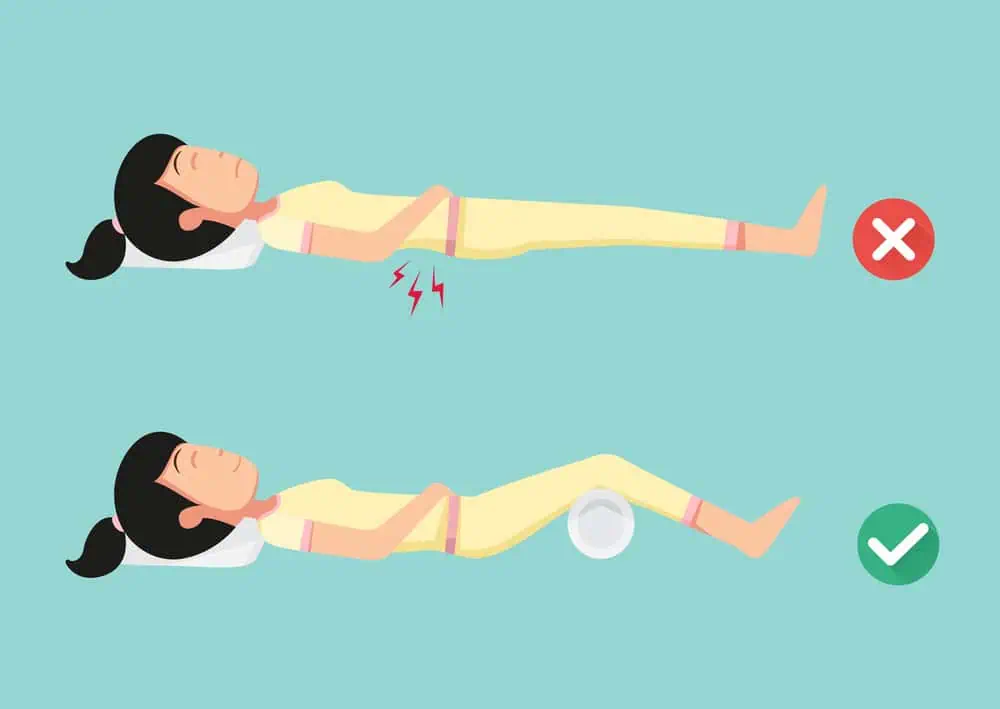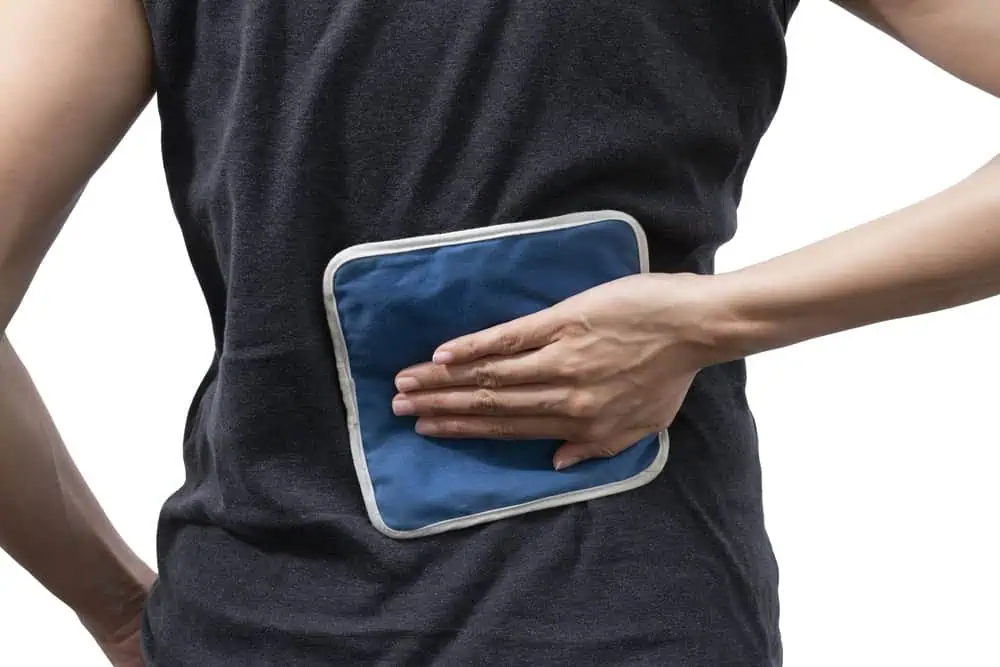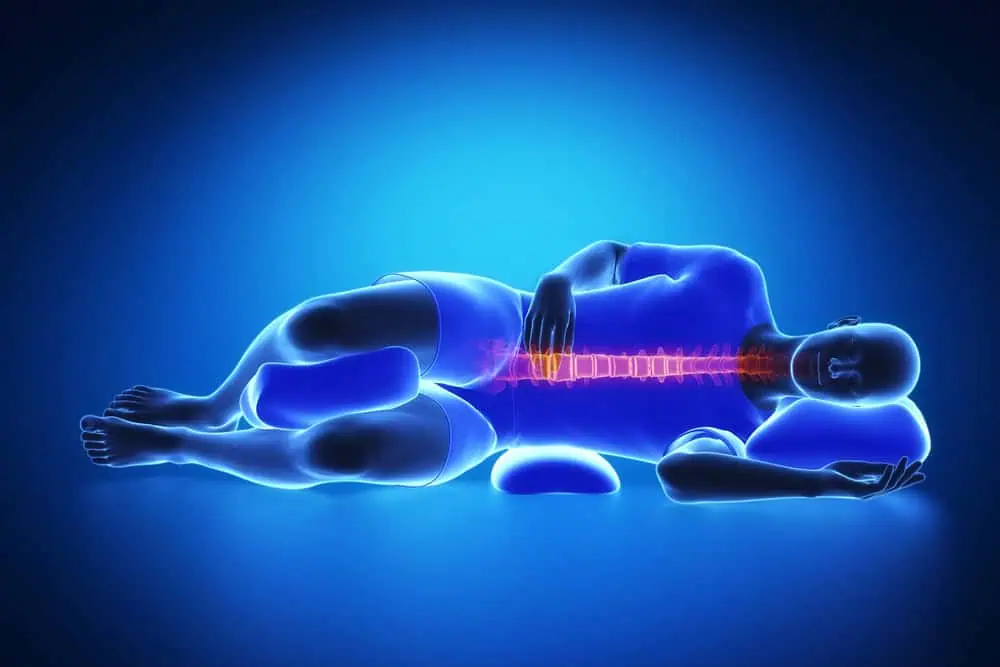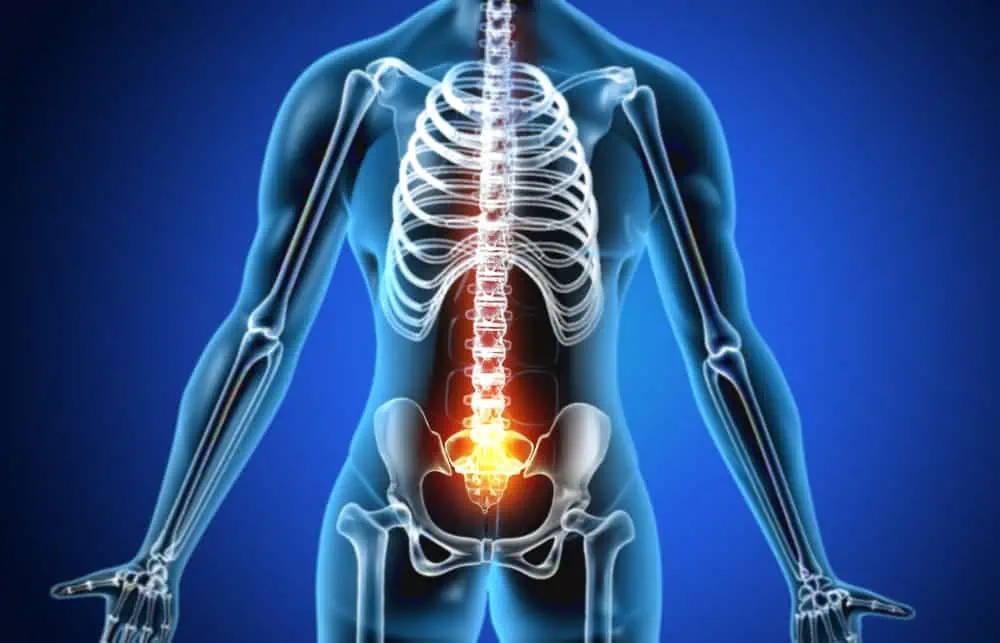Sleeping with SI joint pain can be a daunting challenge. The discomfort and sharp pain in the lower back, associated with the SI joint, often intensify during the night, causing disruptions to sleep quality and overall well-being. We understand that finding a comfortable sleeping position is vital in managing SI joint pain and ensuring a restful night’s sleep. To achieve this, one may need to explore various sleeping positions and supportive accessories that can alleviate the strain on the SI joint.
Managing SI joint pain at night involves a combination of proper sleeping positions, use of heat or cold therapy, and ensuring that daily habits support joint health. Adopting a sleeping position that maintains the natural alignment of the spine is crucial. Moreover, incorporating practices such as gentle stretching before bed or using appropriate sleep accessories like supportive pillows can make a considerable difference in comfort and pain relief. It’s not just how we sleep, but also our daily routines, including physical activity and posture, that play a part in the overall management of SI joint pain.

Key Takeaways
- Identifying supportive sleeping positions can alleviate SI joint discomfort during the night.
- Therapeutic practices and sleep accessories are beneficial for pain management.
- Daytime habits, including exercise and posture, are integral to reducing SI joint pain.
Understanding SI Joint Pain
The sacroiliac (SI) joint is a critical linkage system between our pelvis and lower spine that, when dysfunctional, can lead to chronic discomfort. We’re here to unpack the anatomical structure, common causes and symptoms, and the professional methods used for diagnosing SI joint pain.
Anatomy of the SI Joint
Our SI joint is formed by the connection of the sacrum and the iliac bones (ilia) of the pelvis. This joint is supported by a strong network of ligaments and muscles that contribute to the stability and movement of our lower back and pelvis. Given its pivotal role, any stress or strain on the SI joint can potentially lead to significant discomfort.
Causes and Symptoms
SI joint dysfunction can result from a variety of factors, including:
- Arthritis: Degenerative or inflammatory arthritis can lead to pain and stiffness in the SI joint.
- Pregnancy: Hormonal changes and increased weight can strain the SI joint during pregnancy, causing pain.
- Muscle Imbalance: Differences in muscle strength around the pelvis can cause abnormal stress on the SI joint.
- Trauma: A fall or sudden impact can damage the ligaments around the SI joint leading to dysfunction and pain.
Common symptoms associated with SI joint dysfunction include:
- Pain: Usually located in the lower back, buttock area, or even radiating into the thighs.
- Stiffness: Difficulty moving the affected area comfortably.
- Instability: A sensation of the pelvis feeling like it might give way.
- Tingling or Numbness: Sometimes extending down into the legs or feet.
Professional Diagnosis
A proper diagnosis typically involves a physical exam and may include various tests to rule out other conditions. A physical medicine and rehabilitation specialist often uses specific movements to stress the SI joint and elicit pain that identifies the source. Imaging studies, such as an MRI or X-ray, may be used to provide a clearer picture of the lower spine’s anatomy. This helps ensure that our medical advice is accurate and tailored to provide the most effective pain relief and guidance for physical therapy or other treatment options.
Best Sleeping Positions for SI Joint Pain
Selecting the right sleeping position is crucial for managing SI joint pain effectively. We’re going to explore the adjustments and benefits of different positions to help maximize comfort and support for a peaceful night’s sleep.

Side Sleeping Adjustments
For side sleepers, proper alignment is key. We recommend using a firm pillow between the knees to maintain hip alignment and reduce stress on the SI joint. It’s important to switch sides periodically to prevent pressure buildup. Adequate support for the neck with a properly contoured pillow can also help maintain spinal alignment. We suggest considering the following points for side sleeping:
- Use a firm pillow between the knees.
- Alternate sides throughout the night.
- Ensure good posture by aligning your hips, shoulders, and ears.
Back Sleeping Advantages
Back sleeping inherently supports the natural curvature of the spine, which can be a boon for individuals with SI joint pain. Placing a pillow under the knees can provide additional lumbar support and alleviate lower back pressure. Ensuring your mattress gives sufficient support is also crucial for maintaining proper posture. Here’s what to keep in mind for back sleeping:
- Place a pillow under the knees for lumbar support.
- Ensure your mattress provides adequate support to help maintain natural spine curvature.
Stomach Sleeping Considerations
Stomach sleeping can cause discomfort and exacerbate SI joint pain due to the unnatural twisting of the spine. If you are a stomach sleeper, using a thin pillow or no pillow under the head can help keep your spine more neutrally aligned. Additionally, placing a pillow under the pelvis can decrease the strain on your back. Key considerations for stomach sleeping include:
- Use a thin pillow or no pillow to avoid spinal twist.
- Consider placing a pillow under the pelvis to reduce lower back strain.
Selected Remedies and Treatments
Dealing with SI joint pain requires a careful balance of treatments to reduce inflammation and maintain stability. We’ll explore effective options that provide support and encourage healing, from simple applications to medical interventions.

Application of Heat and Ice
Using heat therapy can increase blood flow and relax tense muscles surrounding the SI joint. We recommend using a low heating pad set to a warm temperature for about 15-20 minutes at a time. On the other hand, ice packs wrapped in a towel and applied to the inflamed area can help reduce swelling. Alternate between cold and heat, ensuring the temperature is comfortable to avoid skin damage.
Safe Stretching and Exercises
Incorporating gentle stretches and physical therapy exercises can help improve stability and support of the pelvic area. Focus on stretching the hip flexors and piriformis muscle, as these are directly linked to SI joint discomfort. A simple exercise like climbing stairs can also be beneficial if done with proper form. However, we caution against overexertion—moderation is key to prevent exacerbating the pain.
Medical Interventions
When conservative methods are not enough, our treatment plan may include more advanced medical interventions. Joint injections with corticosteroids can provide temporary relief by reducing inflammation in the joint space. If long-term, non-surgical treatment is ineffective and pain persists, surgery might be considered as a last resort to stabilize the joint and alleviate pain. Always discuss the risks and benefits of these treatments with a healthcare professional.
Choosing the Right Sleep Accessories
When it comes to managing SI joint pain during sleep, it’s crucial to have the right sleep accessories that provide adequate support and maintain proper alignment. We’ll guide you through selecting the suitable mattress and arranging pillows to help reduce discomfort.

Mattress Selection
Selecting the right mattress is paramount for managing SI joint pain. A supportive mattress that maintains spinal alignment is ideal. We recommend a medium-firm to firm mattress that supports the curves of your body without sinking. This helps in reducing stress on the SI joints. Here’s a quick guide to mattress selection:
- Firmness: Medium-firm to firm to support body weight evenly.
- Material: Memory foam or latex can contour to the body, providing better support.
Pillow Placement for Alignment
Optimizing pillow placement is essential for maintaining the correct sleeping position and achieving spine alignment. A pillow under your knees can alleviate pressure on the SI joint if you sleep on your back. Side sleepers can benefit from a pillow between their knees to keep their hips aligned. Consider these tips for pillow placement:
- Neck Support: Ensure the pillow keeps your neck aligned with your spine.
- Pillows for Side Sleepers: A firm pillow between the knees can help maintain hip alignment.
Proper support and alignment are key to a restful night’s sleep, even with SI joint pain. The right combination of mattress and pillow placement can make a significant difference in managing discomfort.
Daily Habits to Reduce SI Joint Pain

Incorporating daily habits that promote good posture, encourage movement, and facilitate relaxation is crucial to managing SI joint pain. We’ll discuss how posture and ergonomics, movement and breaks, as well as mind-body relaxation techniques can help alleviate discomfort and improve sleep.
Posture and Ergonomics
Good posture is essential for SI joint stability. When sitting, we maintain our posture by choosing chairs with proper lumbar support and keeping our feet flat on the floor. Opting for an ergonomic standing desk can also reduce the stress on our SI joints by allowing us to alternate between sitting and standing throughout the day.
Movement and Regular Breaks
To minimize pain, we make it a practice to integrate motion into our routine. Taking frequent breaks from prolonged positions helps. We ensure to stand, stretch, or walk for a few minutes every hour to relieve pressure on the SI joint. Bending and lifting techniques should also be mindful to avoid additional strain.
Mind-Body Relaxation Techniques
Relaxation techniques such as deep breathing, progressive muscle relaxation, and mindfulness play a significant role in managing stress and discomfort associated with SI joint pain. We apply these practices regularly to promote relaxation and support good sleep hygiene, thereby improving our overall well-being.
Lifestyle Modifications for Better Sleep
When we experience SI joint pain, the way we live our daily lives, from what we eat and drink to how we prevent and manage injuries, can have a profound effect on our sleep quality. Let’s explore targeted lifestyle changes that can help alleviate discomfort and promote better sleep.
Diet and Beverage Choices
Our dietary and beverage choices are vital in managing SI joint pain. Consuming inflammatory foods can lead to increased lower back pain and discomfort. To improve sleep hygiene, it’s recommended to:
- Avoid heavy or large meals within a couple of hours of bedtime.
- Reduce intake of inflammation-inducing foods, such as sugar and refined carbs.
We should also be mindful of our intake of stimulants like caffeine and depressants like alcohol — particularly close to bedtime. While alcohol might help us fall asleep, it can disrupt the second half of the sleep cycle, and caffeine can keep us awake if consumed too late in the day.

Injury Prevention and Management
Preventing exacerbation of existing injuries and managing any low back pain effectively is crucial for improving sleep. We can adopt a few practices:
- Prioritize proper posture to avoid additional strain on the SI joint.
- Engage in gentle, low-impact exercise during the day to strengthen the muscles that support the SI joint, which may reduce discomfort at night.
Using the correct sleeping position can also prevent added stress to our injured areas. For instance, sleeping with the painful side up or in a supine position with a pillow under the knees can help alleviate pressure on the SI joint. It’s also essential to ensure our mattress and pillows provide sufficient support to maintain alignment and reduce stress on the pelvic area.
By strategically adjusting our lifestyle habits, we can foster an environment conducive to restorative sleep, even when managing SI joint pain.
Frequently Asked Questions
In this section, we’ll address some common concerns regarding sacroiliac joint pain during sleep, providing clear and specific advice to enhance your comfort and minimize pain.
What sleeping positions are recommended for someone with sacroiliac joint pain?
For those experiencing sacroiliac joint pain, sleeping on the back with a pillow under the knees can reduce the pressure on the SI joints. Sometimes, lying on the painful side with a pillow between the knees also offers relief.
Are there specific exercises to avoid that can aggravate SI joint pain?
We should avoid high-impact exercises like running or jumping, and activities that involve twisting the spine or heavy lifting, as these may worsen SI joint pain.
Can the use of a pillow during sleep offer relief for SI joint discomfort?
Using a pillow for support during sleep can indeed offer significant relief for SI joint discomfort. Positioning a pillow under the knees when sleeping on your back, or between the knees when sleeping on your side, helps maintain proper spinal alignment.
What actions should be avoided if one is suffering from sacroiliac joint pain?
We should avoid prolonged sitting or standing in one position and making sudden, uncontrolled movements. Gentle turning and transitioning from sitting to standing positions are recommended to reduce strain on the SI joints.
During pregnancy, how can one manage SI joint pain while sleeping?
During pregnancy, managing SI joint pain while sleeping may involve using a body pillow for added support and trying to sleep on the side with the pillow between the knees to maintain pelvic alignment.
How can movement in bed, such as rolling over, be managed to minimize SI joint pain?
To minimize SI joint pain when changing positions in bed, move slowly and deliberately, keeping the hips and shoulders aligned. Engaging the core muscles during movement can also provide additional stability for the SI joints.













